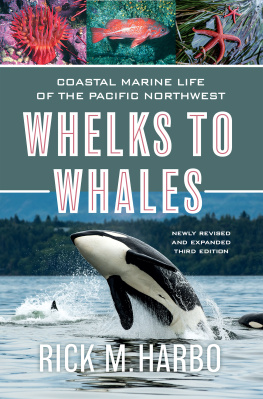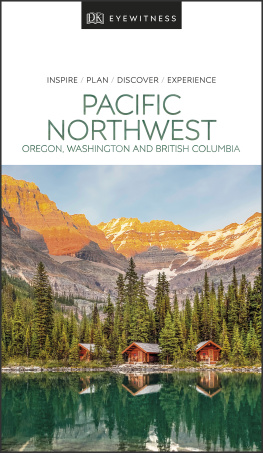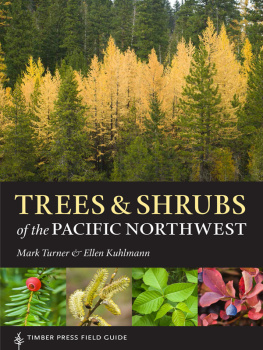
The Northwest Coastal Explorer
Your Guide to the Places, Plants, and Animals of the Pacific Coast
Robert Steelquist

Frontispiece: Extreme Northwest. Cape Flattery is the northwesternmost point in the Lower 48 states.
Copyright 2016 by Robert Steelquist. All rights reserved.
Front cover photos: top by Larry Geddis, bottom third and fourth from right by Tom and Pat Leeson, bottom left by Mac Smith. Back cover photos: left middle by Rowdy Soetisna/Shutterstock.com, left second from top by Mac Smith. All other cover photos by the author.
Text photo and illustration credits appear on .
Published in 2016 by Timber Press, Inc.
The Haseltine Building
133 S.W. Second Avenue, Suite 450
Portland, Oregon 97204-3527
timberpress.com
Text design by McGuire Barber Design
Cover design by Anna Eshelman
eISBN: 978-1-6046-9771-1
Library of Congress Cataloging-in-Publication Data is available.
Dedicated to the memory of Jenny Ann Hall Steelquist, 19522013

Contents
Preface
The challenge I have faced in working on this book has been to pack a geography spanning over nine degrees of Earths latitude into a small book that introduces the natural history of one of Earths most productive coaststhe Pacific Northwest. I chose to start with experienceswhat I learned from exploring the coast from Vancouver Island to northern California, and how Ive shared that knowledge with others as an interpretive naturalist, teacher, writer, parent, and friend.
For the moment, imagine were on the coast now, about to hike into the forest on a trail that will wind along a steep slope as it descends to a remote beach. We can hear the surf faintly, feel the misty breeze, and smell the salty air, fragrant and cool. Well encounter common thingsthe plants and animals that give the Pacific Northwest its particular natural character. We will see trees, shrubs, birds, and amphibians. Stepping onto the beach, our senses will be assaultedthe crash of waves, the vastness of the horizon, and encounters with things that have washed up, or that scurry away as we pass. At the far end, where the sand stops and rocks begin, well prowl tide pools, astonished at the variety of life forms that cling to the rocks or dart to hiding places in the water. This is the experience of exploring the coast. Of meeting its living residents and visitors, learning their connections to everything else and our connections to them.
Before we launch into our outdoor adventures, however, it is important to introduce the region as a whole and the forces that shape it. The introduction to this book touches on geology, climate, and the physical ocean processes that make marine life possible and so productive. It then addresses our roles as stewards of the environmentthe coast and ocean in particular.
The book then introduces major habitat types: coastal forests, rocky shores and tide pools, sand beaches, nearshore, rivers, and estuaries. Each section highlights common plants and animals that you will almost always see. Selecting these wasnt easy, as there are so many to choose from. But each species is important for many reasons. And each is connected, in so many ways, to many other species. They all represent threads in a complex tapestrythe magnificent cloth that we call life.
A getaway guide is also included as a general travel guide to areas where you can experience a variety of habitats in one tripbeaches and tide pools; forests and estuaries. Each region was chosen for its unique variations of natural features, habitats and experiences, learning opportunities, accessibility, and general proximity to the Northwests population centers. Each getaway is offered as an inspirationinformed by my own lifetime of experience in the Pacific Northwestthat can provide a head start to your own research and travel planning.
Proper gear is essential. When we step into the forest, or hike to a beach, we are encountering nature in all its moods. Proper footwear and rain protection, sunglasses and sunscreen, drinking water and snacksall are necessary. Having the right toolsbinoculars, a magnifying glass, a small shovel for probing the sandlets us see farther, look closer, or explore more thoroughly the world around us. In order to help you get properly equipped, comprehensive equipment lists are included in the safety and equipment section.
Learning from others will also enhance your experience in nature. Wherever they are offered, take advantage of guided naturalist walks, interpretive talks, and the publications and online resources of public agencies, nonprofit groups, and commercial guide services. These are the local experts, trained not just on plants and animals unique to their area, but also in ways to make learning fun, with hands-on activities and real-world examples.
Acknowledgments
The process of assembling and writing this book has given me the opportunity to see my own environment with fresh eyes. It has led me deep into my own experiences and knowledge, gained over a lifetime as a Northwest resident and over an entire career working as an outdoor educator and professional conservationist in organizations such as the National Park Service, Washington Department of Fish and Wildlife, and NOAAs Olympic Coast National Marine Sanctuary. It has rekindled in me the excitement of discovering our regions natural wonders. My journey would not have been successful or enjoyable without the help of many.
My sons, Peter and Daniel Steelquist, schooled me, early on, in ways to convey awe and respect for the environment as their parent, travel narrator, and family expedition leader. With their mother, my late wife Jenny, our family traced and retraced, many times, the journeys of discovery that would become this book. Grown men and adventurers on their own now, Peter and Daniel know the stories in this book by heartfiguratively and literallyjust as they know the highways, towns, trails, and beaches of our Northwest homeland. Recalling our past family trips together made my return trips for research especially rewarding.
Scores of colleagues, throughout the years, contributed unknowingly to this book by sharing their knowledge and discoveries with me. In addition to a library of books and papers, I possess a library of memories of hikes, research cruises, field trips, and long conversations about marine resources and their conservation. Special thanks are due to Tom Gaskill and Glen Alexander, who introduced me to their haunts in South Slough and Padilla Bay estuaries. My former colleagues in NOAAs Office of National Marine Sanctuaries, too numerous to name individually, enriched my career, advanced my understanding, and inspired my commitment to the work of marine conservation.
I owe special thanks to the Makah Tribe and the Makah Cultural and Research Center for allowing me access to areas of Makah territory traditionally off limits to nontribal researchers and photographers. Specifically, Janine Ledford, a longtime colleague and friend, and director of the Makah Museum, led me to locations rich with Makah cultural meanings and helped me understand, in my limited way, their profound significance. Rebekah Monette, Dan Greene, and Ben Greene were very generous in providing boat access to marine waters within Makah territory for photography. Yurok Tribal members Bob McConnell and Rosie Clayburn helped me see the Yurok landscape in northern California as I had never seen it before. Likewise, Eirik Thorsgard and Briece Edwards of the Confederated Tribes of the Grand Ronde permitted me glimpses of Native perceptions of the Oregon Coast hidden to most. Exploring these coastal landscapes with such insight vastly enriched my experience.
Next page






